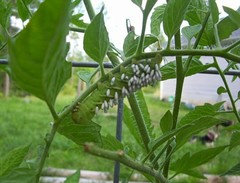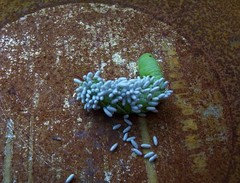Bt and hornworms
Anyone use Bt (Bacillis Thuringiensis) to kill hornworms? I have been noticing hornworms on my tomatoes and was wondering when some of yo give up trying to pick them off and go this method.
There comes a point when I just don't have the time to keep looking for these types of pests. Especially when you can have two generations of hornworms in one season. If you knock out the first generation you will substantially reduce subsequent outbreaks later in the season from the ones that got missed the first time around.
Tom
Comments (17)
tammysf
14 years agolast modified: 9 years agoi have used it and i think it is a great product.
on july 6th i went out to the garden and found 8 or 9 hornworms on my tomato plants. I knew i was going into the hospital the next day and would be gone for 3-4 days so i was worried about the devastation I would come back to if i did not spray. My husband sprayed on 7/6 and to this day there is not one leaf that has any caterpillar/worm damage on it.
Bob_B
14 years agolast modified: 9 years agoI have always used BT wtih great success. One spraying at the sign of black fecal pellets (which rarely lead me to the culprit) generally does it. My guess is that the BT will remain active on the leaves until or unless it is washed off. Here in California that means a whole growing season.
RB
Related Professionals
Hayden Landscape Contractors · Hilton Head Island Landscape Contractors · Mequon Landscape Contractors · Oxnard Landscape Contractors · Round Lake Landscape Contractors · Suisun City Landscape Contractors · Kailua Kona General Contractors · Wyomissing General Contractors · Rolling Meadows Stone, Pavers & Concrete · Maple Grove Decks, Patios & Outdoor Enclosures · Castle Rock Decks, Patios & Outdoor Enclosures · Lansdale Decks, Patios & Outdoor Enclosures · Minneapolis Decks, Patios & Outdoor Enclosures · Olathe Decks, Patios & Outdoor Enclosures · South Lyon Decks, Patios & Outdoor Enclosuresmissingtheobvious
14 years agolast modified: 9 years agoEspecially when you can have two generations of hornworms in one season.
Last year I had a surprise third generation of hornworms in September. I think there were only about 12 of them for the whole summer, though.
avid_hiker
Original Author14 years agolast modified: 9 years agoI found this article about Bt. Half way through the article I had to go back to the top just to make sure I was not reading a commercial advertisement by the manufacturer; but it is written by Colorado State University. This is impressive stuff. It is not toxic to people, animals or benficial insects. It can be used up to the day of harvest. It is not a poison, but natually occuring bacteria that attack the worm's intestinal tract. As soon as the worm eats the Bt it stops feeding and dies within a few days.
This article talks abou three specific strains of Bt that are used to kill quite a number of worms and caterpillars.
I also heard that is very helpful to put a tablespoon of molasses into the mix just before you apply it. Molasses will provide an energy source to the Bt which will make it a lot more effective.
I guess the only thing I can say is, "I'm sold".
Tom
Here is a link that might be useful: Bacillus thuringiensis
carolyn137
14 years agolast modified: 9 years agoTom, there are no live bacteria in the various BT products that have different target populations. That's one of the reasons that BT stuff is sold in opaque bottles, that is, to keep the xstals from being destroyed by heat and sunlight
What's in there are the crystals that the bacteria produce. When the hornworms ingest the xstals the xstals polymerize and form a hole in the worm's stomach and so the worm actually blows up. Ahem.
So no molasses is needed since there are no live bacteria in any BT preps. And being a retired Microbiologist I wouldn't feed MY bacteria molasses anyway.LOL
I wanted to mention that if anyone sees any hornworms with white things on their backs,don't kill them. The worms can be parasitized with a special wasp and when those white eggs hatch the emerging baby wasps eat the horworm right then and there, and having those wasps in the garden area means that it's less likely that hornworms will be a problem.
Carolyn
missingtheobvious
14 years agolast modified: 9 years agoWhile Bt is good for caterpillars, not everything that looks like a caterpillar is a caterpillar. For instance, Pine Sawfly larvae look just like yellow caterpillars -- and they rear up and sway in concert, which is like a scene from some horror movie -- but Bt will not harm them.
On the Conifers forum, I found a recipe for a spray that kills sawfly larvae on contact (16 oz. isopropyl alcohol, 16 oz. water, 1 Tbsp. dishwashing liquid), all of which I had on hand. And that was the end of several dozen bad bugs.
I don't know if this spray would be harmful to tomato plants (the mugo pines had no problem), or if it would kill caterpillars or other bad bugs that eat tomato plants, but I'm thinking of experimenting.
jollyrd
14 years agolast modified: 9 years agomy hornworms appear to carry some eggs on its body
So far only found two of them on my 12 tomatoe plants, no major damage done

tammysf
14 years agolast modified: 9 years agoThose are the wasps eggs carolyn mentioned. You don't want to kill the hornworms that have these eggs as the eggs will hatch into the wasps that kill hornworms.
catman529
14 years agolast modified: 9 years agoActually they are wasp cocoons. The parasitic wasps lay eggs inside the caterpillars, and the larvae hatch and feed off the inside of the caterpillar. Then when they are ready, they emerge from the caterpillar and spin those cocoons that look like eggs.
Since each moth can lay more than 100 eggs there is no way I would ever be able to keep up with trying to manage them by picking them off.
Some moths and butterflies may lay many eggs, but only a small percentage of them actually make it to adulthood. So if you let 2 hornworms pupate and they later emerge as moths, you're not going to get 200 hornworms on your plants, or even 100. Probably the moth would lay eggs on other wild solanaceous weeds and not deposit them all on your tomatoes. And there can always be natural things that could kill eggs or young larvae.
rj_hythloday
14 years agolast modified: 9 years agoI have an old German that is doing very poorly, the only tom not to set fruit yet, though I saw some blossoms the other day and am hopeful. I was inspecting the other day and saw what looked like large mouse droppings on a leaf. Bigger than a grain of rice. Is this hornworm? There is no leaf damage, just lots of leaf curl and some yellowing. It's right by my cukes so I'm worried it may be CMV.
carolyn137
14 years agolast modified: 9 years agoI have an old German that is doing very poorly, the only tom not to set fruit yet, though I saw some blossoms the other day and am hopeful. I was inspecting the other day and saw what looked like large mouse droppings on a leaf. Bigger than a grain of rice. Is this hornworm? There is no leaf damage, just lots of leaf curl and some yellowing. It's right by my cukes so I'm worried it may be CMV.
*****
Trust me, if you had a hornworm problem you'd see the damage to the foliage where they eat it. ( smile)
Also,you'd know if your cukes had CMV by the symptoms they have which is different from the symptoms that CMV shows on tomatoes, which is just not curled leaves; it's much more severe than that with twisted stems and foliage and more.
CMV on cukes and squash and melons is more of a wilt diease with destruction and browning of foliage and is spread by stiped and spotted cuke beetles. And from the time the beetles inject CMV or they can also inject the Bacterial Wilt at tyhe same time, it takes a month or so before you ever see symptoms on them.
Carolyn
neohippie
14 years agolast modified: 9 years agoUgh, here I am trying to eat breakfast and then I come across pictures of parasitized hornworms.
Parasitoid wasps are like the creatures from the movie Alien. Those white things in the picture are the baby wasps that have burst out of the hornworm. By then the hornworm has pretty much been eaten alive from the inside out and is dead.
I know they're beneficial and all but they totally give me the creeps!
Anyway, another vote here for Bt if you don't have enough of the creepy Alien wasps. It kills the worm if the worm eats it, so what I did is just sprayed it on the ends of the tomato branches, since I noticed the worms start there and work their way down. The NEXT DAY there were dead worms hanging all over the place (when they die they don't always fall off the plant).
One word of caution though, Bt kills some beneficial insects, if you consider any butterflies or moths beneficial. It'll kill butterfly caterpillars just as easily as tomato hornworms, so keep that stuff well away from you butterfly gardens! I've heard stories of people spraying a crop with Bt and the overspray drifting into fields of wildflowers killing all the butterfly larvae there.
catman529
14 years agolast modified: 9 years agorj_hythloday -
Probably not a hornworm like Carolyn mentioned. Also, hornworm droppings are more round than rice-shaped, and they have six distinctive grooves around them that sort of makes them look like they went through a flower-shaped hole punch or something like that.
avid_hiker
Original Author14 years agolast modified: 9 years agoI found this on the manufacturers website. I then called Organic-Gardening Shop.com and confirmed what I was reading. In the end: It appears that the Bacilius Thuingiensis in the bottle is a living spoor that will reproduce and grow. It is more than just the crystals the bacteria produce. The spoors have been suspended during processing and upon dilution and application by the gardener they regain their activity and begin to reproduce and multiply. While direct sunlight (UV light) does tend to harm the bacteria heat does not harm the bacteria. This is why the manufacturer recommends applying the Bt with a sprayer so that the underside of the plant leaves can be treated; because most leaf eating worms/caterpillars do their eating from the underside of the leaf. Applying Bt to the underside will increase the number of spoors the worm will ingest - hence causing it to die faster. Finally, since Bt attacks the worms digestive system it begins to work almost immediately. Almost as soon as the worm eats the Bt it stops eating.
My comment about applying molasses in the mix in order to provide an energy source for the bacteria came from Dr. Elaine Ingham of The Soil Food Web. She is one of the formost authorities on plant related bacteria and her findings of the last 4 or 5 years indicate that bacteria are not just found in the soil, but cover the plants as well. This why it is recommended to apply a little molasses to the mix. Molasses is one of the best energy sources available for bactria. If the Bt spoors have a food source on the plant they will remain alive and thus able to continue killing new infestations for a longer time resulting in longer intervals between applications (the limiting factor is of course precipitation washing the plant clean of the Bt and molasses). It appears molasses can be very beneficial, not only for the microbes in the soil but also for the bacteria that literally cover the outside of all plants.
The following was taken from the fact sheet about Bt on the manufacturers website. I have included the link to the website if anyone wants to read it in its entirety. The website also contains the phone numbers for contacting the company if there are any questions.
"Bacillus thuringiensis (Bt) is a naturally occurring, soil borne organism that has gained recent popularity for its ability to control certain insect pests in a natural, environmentally friendly manner. Bacterial agents, like Bt, are effective in controlling insects in the larva stage only. The larva stage in an insects life cycle is the stage during which most of the feeding occurs. Since Bt must be ingested to work, the insect must be controlled during the larval stage. The larval stage is the stage in which the insect appears worm or caterpillar-like. The Bt is applied to the foliage of plants infested with a leaf or needle eating larva. If possible, apply the Bt to the underside of the leaf surface for two reasons: 1) Most larvas feed from the underside of the leaf surface. 2) Bt is broken down faster in sunlight. Application to the undersides of the leaf surfaces will prolong Bt's activity. High temperatures do not encourage Bt's breakdown."
"After Bt spores are ingested by larvae, they grow and reproduce, meanwhile producing crystalline toxins. The crystalline toxins paralyze the digestive tract of the larvae causing it to cease eating. Death will follow, but time of death can range anywhere from 12 hours to 5 days after ingestion. This depends on the amount of Bt ingested, the size and variety of the larvae and variety of Bt used for control. There are different strains or varieties of Bt available that have been selected for the control of specific insects. Bt variety kurstaki (BTK) controls the European corn borer, tomato hornworms, fruit worms, cabbageworm, cabbage looper, spring and fall cankerworm, spruce budworm, and other caterpillar-like larvae. Bt variety san diego (BTSD) controls early larvae of the Colorado potato beetle. Bt variety israelensis (BTI) controls mosquitoes, black flies and fungus gnats."
"The use of Bt has gained well-earned popularity because of its distinct advantages over other pesticides. Hazards to humans are negligible although inhalation or contact with eyes or open wounds should be avoided. Bt can be used right up until harvest, which allows for a longer term control as compared to other insecticides requiring a waiting period from time of application to time of harvest. There is no waiting period from time of application before re-entering the field. The different strains of Bt are class-specific, meaning beneficial or non-target insects are not harmed. The insects that ingest the Bt and later die from it are not considered dangerous to birds or other animals that may feed on the dead insect. Bt is not known to cause injury to plants on which it has been applied and is not considered harmful to the environment."
Hope this helps a little.
Tom
rj_hythloday
14 years agolast modified: 9 years agoEspoma Tomatotone has both BT and BS Bacillus Subtillis, Applied to the soil is it going to be as effective as if it were a foliar spray?
Serenade is used to treat all sorts of fungal diseases as a foliar spray. I've considered adding a bit of tomato tone to the AVCT next time I brew it.
eloquinn
14 years agolast modified: 9 years agoI used BT for the first time this year and it has worked wonders. Last year I lost 80% or more of my cucumbers to worms and had a lot of hornworm damage on my tomato plants. This year I've done my best to spray all my plants every 2-4 weeks and I haven't seen a single cucumber worm or hornworm.
Now if I could just figure out an easy way to deal with the squash bugs and stink bugs I'd be set. So far I've just been flicking them off into a jar of soapy water when I spot them but the squash bugs in particular are eating up the leaves on my squash and cucumbers and the stink bugs have stung and ruined quite a few of my tomatoes.







avid_hikerOriginal Author